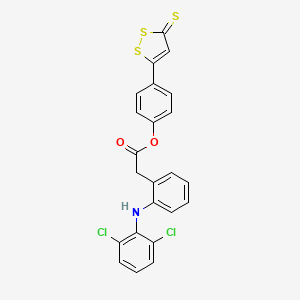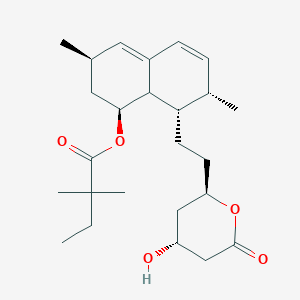
Simvastatine
Vue d'ensemble
Description
La simvastatine est un médicament hypolipidémiant appartenant à la classe des statines. Elle est principalement utilisée pour réduire les taux élevés de lipides et diminuer le risque d’événements cardiovasculaires tels que les crises cardiaques et les accidents vasculaires cérébraux. La this compound agit en inhibant l’enzyme hydroxymethylglutaryl-coenzyme A (HMG-CoA) réductase, qui joue un rôle crucial dans la biosynthèse du cholestérol .
Mécanisme D'action
La simvastatine exerce ses effets en inhibant de manière compétitive la HMG-CoA réductase, l’enzyme responsable de la conversion du HMG-CoA en acide mévalonique, un précurseur de la biosynthèse du cholestérol . Cette inhibition entraîne une diminution de la synthèse du cholestérol dans le foie, ce qui entraîne une diminution des taux de cholestérol lipoprotéique de basse densité (LDL) dans le sang. De plus, la this compound a des effets pléiotropes, notamment des propriétés anti-inflammatoires et antioxydantes .
Applications De Recherche Scientifique
Simvastatin has a wide range of scientific research applications:
Medicine: It is extensively used to manage dyslipidemia and prevent cardiovascular diseases.
Bone Regeneration: Research has shown that simvastatin can promote bone regeneration, making it a potential treatment for conditions like osteoporosis.
Antimicrobial Properties: Simvastatin has demonstrated antimicrobial effects, which are being explored for potential therapeutic applications.
Analyse Biochimique
Biochemical Properties
Simvastatin interacts with the enzyme HMG-CoA reductase, which is the key rate-limiting enzyme in the cholesterol biosynthetic pathway . By competitively inhibiting this enzyme, simvastatin not only reduces the cellular production of cholesterol but also affects the biosynthesis of several intermediates of the mevalonate pathway, such as farnesylpyrophosphate and geranylgeranylpyrophosphate .
Cellular Effects
Simvastatin has been shown to have profound effects on various types of cells and cellular processes. For instance, it has been found to inhibit glucose metabolism and legumain activity in human myotubes . It also exerts inhibitory effects on the NLRP3 inflammasome and toll-like receptors, which are implicated in inflammation and atherosclerosis .
Molecular Mechanism
Simvastatin exerts its effects at the molecular level by inhibiting the conversion of HMG-CoA to mevalonic acid, a key step in the cholesterol synthesis pathway . This inhibition is achieved by the competitive inhibition of the enzyme HMG-CoA reductase . Furthermore, simvastatin can suppress TLR4/MyD88/NF-ĸB signaling and cause an immune response shift to an anti-inflammatory response .
Temporal Effects in Laboratory Settings
In laboratory settings, simvastatin has been shown to cause a dose-dependent decrease in both glucose uptake and oxidation in mature myotubes . Moreover, long-term studies indicate that little or no attenuation of these changes in serum lipid and lipoprotein levels occurred with administration of simvastatin for 3 to 5.4 years .
Dosage Effects in Animal Models
In animal models, simvastatin has been shown to cause bioaccumulation over time, which was augmented upon addition of bile acids . High doses of simvastatin have been associated with increased osteoporosis risk , and extensive muscle-specific damage, particularly in the organization of sarcomeres and in mitochondria .
Metabolic Pathways
Simvastatin is involved in the cholesterol biosynthesis pathway, where it inhibits the conversion of HMG-CoA to mevalonic acid . This action not only inhibits the cellular production of cholesterol but also affects the biosynthesis of several intermediates of the mevalonate pathway .
Transport and Distribution
Simvastatin is transported into bacteria cells leading to a drug bioaccumulation over time, which is augmented upon addition of bile acids . A decrease of total drug level during the incubation indicates that the drug is partly biotransformed by bacterial enzymes .
Subcellular Localization
Simvastatin has been shown to cause alterations in the intracellular distribution of lysosomal cysteine proteases . In addition, protein isoprenylation permits the covalent attachment, subcellular localization, and intracellular trafficking of membrane-associated proteins .
Méthodes De Préparation
La simvastatine est synthétisée à partir d’un produit de fermentation du champignon Aspergillus terreus. La voie de synthèse implique plusieurs étapes clés :
Fermentation : La première étape implique la fermentation d’Aspergillus terreus pour produire le composé précurseur.
Modification chimique : Le précurseur subit des modifications chimiques, y compris l’estérification et la lactonisation, pour former la this compound.
Les méthodes de production industrielle se concentrent sur l’optimisation de ces étapes pour garantir un rendement et une pureté élevés. Le processus implique un contrôle rigoureux des conditions réactionnelles telles que la température, le pH et l’utilisation de solvants pour obtenir le produit souhaité.
Analyse Des Réactions Chimiques
La simvastatine subit plusieurs types de réactions chimiques :
Réduction et substitution : Ces réactions sont moins courantes mais peuvent se produire dans des conditions spécifiques.
Les réactifs couramment utilisés dans ces réactions comprennent l’eau pour l’hydrolyse et les enzymes du cytochrome P450 pour l’oxydation. Les principaux produits formés comprennent la forme active d’acide β-hydroxy et divers métabolites oxydés.
4. Applications de la recherche scientifique
La this compound a un large éventail d’applications de recherche scientifique :
Médecine : Elle est largement utilisée pour gérer la dyslipidémie et prévenir les maladies cardiovasculaires.
Régénération osseuse : La recherche a montré que la this compound peut favoriser la régénération osseuse, ce qui en fait un traitement potentiel pour des affections comme l’ostéoporose.
Propriétés antimicrobiennes : La this compound a démontré des effets antimicrobiens, qui sont explorés pour des applications thérapeutiques potentielles.
Comparaison Avec Des Composés Similaires
La simvastatine est souvent comparée à d’autres statines telles que l’atorvastatine, la rosuvastatine, la pravastatine, la fluvastatine et la lovastatine. Bien que tous ces composés partagent un mécanisme d’action similaire, ils diffèrent par leurs propriétés pharmacocinétiques, leur puissance et leurs profils d’effets secondaires . Par exemple :
Atorvastatine : Connue pour sa forte puissance et sa demi-vie plus longue que la this compound.
Rosuvastatine : A une efficacité plus élevée pour abaisser le cholestérol LDL mais peut provoquer plus d’effets secondaires musculaires.
Pravastatine : Moins lipophile et a moins d’interactions médicamenteuses que la this compound.
La capacité unique de la this compound à traverser la barrière hémato-encéphalique et son utilisation extensive dans la gestion des maladies cardiovasculaires mettent en évidence ses avantages distincts .
Propriétés
IUPAC Name |
[(1S,3R,7S,8S,8aR)-8-[2-[(2R,4R)-4-hydroxy-6-oxooxan-2-yl]ethyl]-3,7-dimethyl-1,2,3,7,8,8a-hexahydronaphthalen-1-yl] 2,2-dimethylbutanoate | |
|---|---|---|
| Source | PubChem | |
| URL | https://pubchem.ncbi.nlm.nih.gov | |
| Description | Data deposited in or computed by PubChem | |
InChI |
InChI=1S/C25H38O5/c1-6-25(4,5)24(28)30-21-12-15(2)11-17-8-7-16(3)20(23(17)21)10-9-19-13-18(26)14-22(27)29-19/h7-8,11,15-16,18-21,23,26H,6,9-10,12-14H2,1-5H3/t15-,16-,18+,19+,20-,21-,23-/m0/s1 | |
| Source | PubChem | |
| URL | https://pubchem.ncbi.nlm.nih.gov | |
| Description | Data deposited in or computed by PubChem | |
InChI Key |
RYMZZMVNJRMUDD-HGQWONQESA-N | |
| Source | PubChem | |
| URL | https://pubchem.ncbi.nlm.nih.gov | |
| Description | Data deposited in or computed by PubChem | |
Canonical SMILES |
CCC(C)(C)C(=O)OC1CC(C=C2C1C(C(C=C2)C)CCC3CC(CC(=O)O3)O)C | |
| Source | PubChem | |
| URL | https://pubchem.ncbi.nlm.nih.gov | |
| Description | Data deposited in or computed by PubChem | |
Isomeric SMILES |
CCC(C)(C)C(=O)O[C@H]1C[C@H](C=C2[C@H]1[C@H]([C@H](C=C2)C)CC[C@@H]3C[C@H](CC(=O)O3)O)C | |
| Source | PubChem | |
| URL | https://pubchem.ncbi.nlm.nih.gov | |
| Description | Data deposited in or computed by PubChem | |
Molecular Formula |
C25H38O5 | |
| Source | PubChem | |
| URL | https://pubchem.ncbi.nlm.nih.gov | |
| Description | Data deposited in or computed by PubChem | |
DSSTOX Substance ID |
DTXSID0023581 | |
| Record name | Simvastatin | |
| Source | EPA DSSTox | |
| URL | https://comptox.epa.gov/dashboard/DTXSID0023581 | |
| Description | DSSTox provides a high quality public chemistry resource for supporting improved predictive toxicology. | |
Molecular Weight |
418.6 g/mol | |
| Source | PubChem | |
| URL | https://pubchem.ncbi.nlm.nih.gov | |
| Description | Data deposited in or computed by PubChem | |
Physical Description |
Solid | |
| Record name | Simvastatin | |
| Source | Human Metabolome Database (HMDB) | |
| URL | http://www.hmdb.ca/metabolites/HMDB0005007 | |
| Description | The Human Metabolome Database (HMDB) is a freely available electronic database containing detailed information about small molecule metabolites found in the human body. | |
| Explanation | HMDB is offered to the public as a freely available resource. Use and re-distribution of the data, in whole or in part, for commercial purposes requires explicit permission of the authors and explicit acknowledgment of the source material (HMDB) and the original publication (see the HMDB citing page). We ask that users who download significant portions of the database cite the HMDB paper in any resulting publications. | |
Solubility |
Insoluble, In water, 3.0X10-2 mg/L, temp not specified, Solubility (mg/mL): chloroform 610; DMSO 540; methanol 200; ethanol 160; n-hexane 0.15; 0.1 M HCl 0.06; polyethylene glycol-400 70; propylene glycol 30; 0.1 M NaOH 70, 1.22e-02 g/L | |
| Record name | Simvastatin | |
| Source | DrugBank | |
| URL | https://www.drugbank.ca/drugs/DB00641 | |
| Description | The DrugBank database is a unique bioinformatics and cheminformatics resource that combines detailed drug (i.e. chemical, pharmacological and pharmaceutical) data with comprehensive drug target (i.e. sequence, structure, and pathway) information. | |
| Explanation | Creative Common's Attribution-NonCommercial 4.0 International License (http://creativecommons.org/licenses/by-nc/4.0/legalcode) | |
| Record name | Simvastatin | |
| Source | Hazardous Substances Data Bank (HSDB) | |
| URL | https://pubchem.ncbi.nlm.nih.gov/source/hsdb/7208 | |
| Description | The Hazardous Substances Data Bank (HSDB) is a toxicology database that focuses on the toxicology of potentially hazardous chemicals. It provides information on human exposure, industrial hygiene, emergency handling procedures, environmental fate, regulatory requirements, nanomaterials, and related areas. The information in HSDB has been assessed by a Scientific Review Panel. | |
| Record name | Simvastatin | |
| Source | Human Metabolome Database (HMDB) | |
| URL | http://www.hmdb.ca/metabolites/HMDB0005007 | |
| Description | The Human Metabolome Database (HMDB) is a freely available electronic database containing detailed information about small molecule metabolites found in the human body. | |
| Explanation | HMDB is offered to the public as a freely available resource. Use and re-distribution of the data, in whole or in part, for commercial purposes requires explicit permission of the authors and explicit acknowledgment of the source material (HMDB) and the original publication (see the HMDB citing page). We ask that users who download significant portions of the database cite the HMDB paper in any resulting publications. | |
Mechanism of Action |
Simvastatin is a prodrug in which the 6-membered lactone ring of simvastatin is hydrolyzed in vivo to generate the beta,delta-dihydroxy acid, an active metabolite structurally similar to HMG-CoA (hydroxymethylglutaryl CoA). Once hydrolyzed, simvastatin competes with HMG-CoA for HMG-CoA reductase, a hepatic microsomal enzyme, which catalyzes the conversion of HMG-CoA to mevalonate, an early rate-limiting step in cholesterol biosynthesis. Simvastatin acts primarily in the liver, where decreased hepatic cholesterol concentrations stimulate the upregulation of hepatic low density lipoprotein (LDL) receptors which increases hepatic uptake of LDL. Simvastatin also inhibits hepatic synthesis of very low density lipoprotein (VLDL). The overall effect is a decrease in plasma LDL and VLDL. At therapeutic doses, the HMG-CoA enzyme is not completely blocked by simvastatin activity, thereby allowing biologically necessary amounts of mevalonate to remain available. As mevalonate is an early step in the biosynthetic pathway for cholesterol, therapy with simvastatin would also not be expected to cause any accumulation of potentially toxic sterols. In addition, HMG-CoA is metabolized readily back to acetyl-CoA, which participates in many biosynthetic processes in the body. In vitro and in vivo animal studies also demonstrate that simvastatin exerts vasculoprotective effects independent of its lipid-lowering properties, also known as the pleiotropic effects of statins. This includes improvement in endothelial function, enhanced stability of atherosclerotic plaques, reduced oxidative stress and inflammation, and inhibition of the thrombogenic response. Statins have also been found to bind allosterically to β2 integrin function-associated antigen-1 (LFA-1), which plays an important role in leukocyte trafficking and in T cell activation., Simvastatin is a prodrug and is hydrolyzed to its active beta-hydroxyacid form, simvastatin acid, after administration. Simvastatin is a specific inhibitor of 3-hydroxy-3-methylglutaryl-coenzyme A (HMG-CoA) reductase, the enzyme that catalyzes the conversion of HMG-CoA to mevalonate, an early and rate limiting step in the biosynthetic pathway for cholesterol. In addition, simvastatin reduces VLDL and TG and increases HDL-C., The HDL-associated enzyme paraoxonase protects LDLs from oxidative stress. 3-Hydroxy-3-methylglutaryl coenzyme A reductase inhibitors (statins) appear to favorably influence the atherosclerotic process by different mechanisms. The present study examined the influence of simvastatin on paraoxonase expression and serum paraoxonase levels. Simvastatin upregulated in a dose-dependent manner the activity of the promoter of the paraoxonase gene in expression cassettes transfected into HepG2 cells. Upregulation could be blocked by mevalonate and other intermediates of the cholesterol biosynthetic pathway. Simvastatin increased nuclear factors, notably sterol regulatory element-binding protein-2, capable of binding to the paraoxonase promoter; this was also blocked by mevalonate. Sterol regulatory element-binding protein-2 upregulated promoter activity in vitro. Patients treated with statin showed a significant increase in serum concentrations and activities of paraoxonase. The data indicate that simvastatin can modulate expression in vitro of the antioxidant enzyme paraoxonase and is associated with increased serum paraoxonase concentration and activity. It is consistent with effects of simvastatin treatment, which have the potential to influence beneficially antiatherogenic mechanisms at the HDL level. The study provides evidence for 1 molecular mechanism by which paraoxonase gene expression could be regulated., ... We report in this work that, unexpectedly, simvastatin enhances LPS-induced IL-12p40 production by murine macrophages, and that it does so by activating the IL-12p40 promoter. Mutational analysis and dominant-negative expression studies indicate that both C/EBP and AP-1 transcription factors have a crucial role in promoter activation. This occurs via a c-Fos- and c-Jun-based mechanism; we demonstrate that ectopic expression of c-Jun activates the IL-12p40 promoter, whereas expression of c-Fos inhibits IL-12p40 promoter activity. Simvastatin prevents LPS-induced c-Fos expression, thereby relieving the inhibitory effect of c-Fos on the IL-12p40 promoter. Concomitantly, simvastatin induces the phosphorylation of c-Jun by the c-Jun N-terminal kinase, resulting in c-Jun-dependent activation of the IL-12p40 promoter. This appears to be a general mechanism because simvastatin also augments LPS-dependent activation of the TNF-alpha promoter, perhaps because the TNF-alpha promoter has C/EBP and AP-1 binding sites in a similar configuration to the IL-12p40 promoter. The fact that simvastatin potently augments LPS-induced IL-12p40 and TNF-alpha production has implications for the treatment of bacterial infections in statin-treated patients., Statins are increasingly recognized as mediators of direct cellular effects independent of their lipid lowering capacity. Therefore, the time and concentration dependence of various statin-mediated cellular alterations was compared in renal mesangial cells. The effects of statins on cell proliferation, gene expression, cytoskeletal alterations, apoptosis, and cytotoxicity were analyzed in cultured mesangial cells using standard techniques. Results. Simvastatin and lovastatin decreased proliferation and cell number of rat mesangial cells concentration-dependently. Concurrently, the expression of the fibrogenic protein connective tissue growth factor (CTGF) was impaired and actin stress fibers, which are typical of mesangial cells in culture, became disassembled by simvastatin. A decrease of the posttranslational modification of RhoA by geranylgeranyl moieties was detected, supporting a role for RhoA as mediator of statin effects. Induction of apoptosis, determined by activation of caspase-3 and DNA fragmentation, and necrosis only occurred at later time points, when the morphology of the cells was strongly altered and the cells detached from the surface due to changes in the actin cytoskeleton. Basically, the same results were obtained with a human mesangial cell line. Furthermore, statin effects were mimicked by inhibition of the geranylgeranyltransferase. Most of the cellular effects of the lipophilic statins occurred within the same time and concentration range, suggesting a common molecular mechanism. Only apoptosis and necrosis were observed at later time points or with higher concentrations of simvastatin and thus seem to be secondary to the changes in gene expression and alterations of the actin cytoskeleton., For more Mechanism of Action (Complete) data for Simvastatin (6 total), please visit the HSDB record page. | |
| Record name | Simvastatin | |
| Source | DrugBank | |
| URL | https://www.drugbank.ca/drugs/DB00641 | |
| Description | The DrugBank database is a unique bioinformatics and cheminformatics resource that combines detailed drug (i.e. chemical, pharmacological and pharmaceutical) data with comprehensive drug target (i.e. sequence, structure, and pathway) information. | |
| Explanation | Creative Common's Attribution-NonCommercial 4.0 International License (http://creativecommons.org/licenses/by-nc/4.0/legalcode) | |
| Record name | Simvastatin | |
| Source | Hazardous Substances Data Bank (HSDB) | |
| URL | https://pubchem.ncbi.nlm.nih.gov/source/hsdb/7208 | |
| Description | The Hazardous Substances Data Bank (HSDB) is a toxicology database that focuses on the toxicology of potentially hazardous chemicals. It provides information on human exposure, industrial hygiene, emergency handling procedures, environmental fate, regulatory requirements, nanomaterials, and related areas. The information in HSDB has been assessed by a Scientific Review Panel. | |
Color/Form |
White to off-white crystalline powder from n-butyl chloride + hexane | |
CAS No. |
79902-63-9 | |
| Record name | Simvastatin | |
| Source | CAS Common Chemistry | |
| URL | https://commonchemistry.cas.org/detail?cas_rn=79902-63-9 | |
| Description | CAS Common Chemistry is an open community resource for accessing chemical information. Nearly 500,000 chemical substances from CAS REGISTRY cover areas of community interest, including common and frequently regulated chemicals, and those relevant to high school and undergraduate chemistry classes. This chemical information, curated by our expert scientists, is provided in alignment with our mission as a division of the American Chemical Society. | |
| Explanation | The data from CAS Common Chemistry is provided under a CC-BY-NC 4.0 license, unless otherwise stated. | |
| Record name | Simvastatin [USAN:USP:INN:BAN] | |
| Source | ChemIDplus | |
| URL | https://pubchem.ncbi.nlm.nih.gov/substance/?source=chemidplus&sourceid=0079902639 | |
| Description | ChemIDplus is a free, web search system that provides access to the structure and nomenclature authority files used for the identification of chemical substances cited in National Library of Medicine (NLM) databases, including the TOXNET system. | |
| Record name | Simvastatin | |
| Source | DrugBank | |
| URL | https://www.drugbank.ca/drugs/DB00641 | |
| Description | The DrugBank database is a unique bioinformatics and cheminformatics resource that combines detailed drug (i.e. chemical, pharmacological and pharmaceutical) data with comprehensive drug target (i.e. sequence, structure, and pathway) information. | |
| Explanation | Creative Common's Attribution-NonCommercial 4.0 International License (http://creativecommons.org/licenses/by-nc/4.0/legalcode) | |
| Record name | simvastatin | |
| Source | DTP/NCI | |
| URL | https://dtp.cancer.gov/dtpstandard/servlet/dwindex?searchtype=NSC&outputformat=html&searchlist=758706 | |
| Description | The NCI Development Therapeutics Program (DTP) provides services and resources to the academic and private-sector research communities worldwide to facilitate the discovery and development of new cancer therapeutic agents. | |
| Explanation | Unless otherwise indicated, all text within NCI products is free of copyright and may be reused without our permission. Credit the National Cancer Institute as the source. | |
| Record name | Simvastatin | |
| Source | EPA DSSTox | |
| URL | https://comptox.epa.gov/dashboard/DTXSID0023581 | |
| Description | DSSTox provides a high quality public chemistry resource for supporting improved predictive toxicology. | |
| Record name | Butanoic acid, 2,2-dimethyl-, (1S,3R,7S,8S,8aR)-1,2,3,7,8,8a-hexahydro-3,7-dimethyl-8-[2-[(2R,4R)-tetrahydro-4-hydroxy-6-oxo-2H-pyran-2-yl]ethyl]-1-naphthalenyl ester | |
| Source | European Chemicals Agency (ECHA) | |
| URL | https://echa.europa.eu/substance-information/-/substanceinfo/100.115.749 | |
| Description | The European Chemicals Agency (ECHA) is an agency of the European Union which is the driving force among regulatory authorities in implementing the EU's groundbreaking chemicals legislation for the benefit of human health and the environment as well as for innovation and competitiveness. | |
| Explanation | Use of the information, documents and data from the ECHA website is subject to the terms and conditions of this Legal Notice, and subject to other binding limitations provided for under applicable law, the information, documents and data made available on the ECHA website may be reproduced, distributed and/or used, totally or in part, for non-commercial purposes provided that ECHA is acknowledged as the source: "Source: European Chemicals Agency, http://echa.europa.eu/". Such acknowledgement must be included in each copy of the material. ECHA permits and encourages organisations and individuals to create links to the ECHA website under the following cumulative conditions: Links can only be made to webpages that provide a link to the Legal Notice page. | |
| Record name | (1S,3R,7S,8S,8aS)-1,2,3,7,8,8a-Hexahydro-3,7-dimethyl-8-{2-[(4R,6R)-tetrahydro-4-hydroxy-2-oxo-2H-pyran-6-yl]ethyl}-1-naphthyl-2,2-dimethylbutyrat | |
| Source | European Chemicals Agency (ECHA) | |
| URL | https://echa.europa.eu/information-on-chemicals | |
| Description | The European Chemicals Agency (ECHA) is an agency of the European Union which is the driving force among regulatory authorities in implementing the EU's groundbreaking chemicals legislation for the benefit of human health and the environment as well as for innovation and competitiveness. | |
| Explanation | Use of the information, documents and data from the ECHA website is subject to the terms and conditions of this Legal Notice, and subject to other binding limitations provided for under applicable law, the information, documents and data made available on the ECHA website may be reproduced, distributed and/or used, totally or in part, for non-commercial purposes provided that ECHA is acknowledged as the source: "Source: European Chemicals Agency, http://echa.europa.eu/". Such acknowledgement must be included in each copy of the material. ECHA permits and encourages organisations and individuals to create links to the ECHA website under the following cumulative conditions: Links can only be made to webpages that provide a link to the Legal Notice page. | |
| Record name | (1S,3R,7S,8S,8aR)-8-[2-[(2R,4R)-4-Hydroxy-6-oxotetrahydro-2H-pyran-2-yl]ethyl]-3,7-dimethyl-1,2,3,7,8,8a-hexahydronaphthalen-1-yl 2,2-dimethylbutanoate. | |
| Source | European Chemicals Agency (ECHA) | |
| URL | https://echa.europa.eu/information-on-chemicals | |
| Description | The European Chemicals Agency (ECHA) is an agency of the European Union which is the driving force among regulatory authorities in implementing the EU's groundbreaking chemicals legislation for the benefit of human health and the environment as well as for innovation and competitiveness. | |
| Explanation | Use of the information, documents and data from the ECHA website is subject to the terms and conditions of this Legal Notice, and subject to other binding limitations provided for under applicable law, the information, documents and data made available on the ECHA website may be reproduced, distributed and/or used, totally or in part, for non-commercial purposes provided that ECHA is acknowledged as the source: "Source: European Chemicals Agency, http://echa.europa.eu/". Such acknowledgement must be included in each copy of the material. ECHA permits and encourages organisations and individuals to create links to the ECHA website under the following cumulative conditions: Links can only be made to webpages that provide a link to the Legal Notice page. | |
| Record name | SIMVASTATIN | |
| Source | FDA Global Substance Registration System (GSRS) | |
| URL | https://gsrs.ncats.nih.gov/ginas/app/beta/substances/AGG2FN16EV | |
| Description | The FDA Global Substance Registration System (GSRS) enables the efficient and accurate exchange of information on what substances are in regulated products. Instead of relying on names, which vary across regulatory domains, countries, and regions, the GSRS knowledge base makes it possible for substances to be defined by standardized, scientific descriptions. | |
| Explanation | Unless otherwise noted, the contents of the FDA website (www.fda.gov), both text and graphics, are not copyrighted. They are in the public domain and may be republished, reprinted and otherwise used freely by anyone without the need to obtain permission from FDA. Credit to the U.S. Food and Drug Administration as the source is appreciated but not required. | |
| Record name | Simvastatin | |
| Source | Hazardous Substances Data Bank (HSDB) | |
| URL | https://pubchem.ncbi.nlm.nih.gov/source/hsdb/7208 | |
| Description | The Hazardous Substances Data Bank (HSDB) is a toxicology database that focuses on the toxicology of potentially hazardous chemicals. It provides information on human exposure, industrial hygiene, emergency handling procedures, environmental fate, regulatory requirements, nanomaterials, and related areas. The information in HSDB has been assessed by a Scientific Review Panel. | |
| Record name | Simvastatin | |
| Source | Human Metabolome Database (HMDB) | |
| URL | http://www.hmdb.ca/metabolites/HMDB0005007 | |
| Description | The Human Metabolome Database (HMDB) is a freely available electronic database containing detailed information about small molecule metabolites found in the human body. | |
| Explanation | HMDB is offered to the public as a freely available resource. Use and re-distribution of the data, in whole or in part, for commercial purposes requires explicit permission of the authors and explicit acknowledgment of the source material (HMDB) and the original publication (see the HMDB citing page). We ask that users who download significant portions of the database cite the HMDB paper in any resulting publications. | |
Melting Point |
135-138 °C, 135 - 138 °C | |
| Record name | Simvastatin | |
| Source | DrugBank | |
| URL | https://www.drugbank.ca/drugs/DB00641 | |
| Description | The DrugBank database is a unique bioinformatics and cheminformatics resource that combines detailed drug (i.e. chemical, pharmacological and pharmaceutical) data with comprehensive drug target (i.e. sequence, structure, and pathway) information. | |
| Explanation | Creative Common's Attribution-NonCommercial 4.0 International License (http://creativecommons.org/licenses/by-nc/4.0/legalcode) | |
| Record name | Simvastatin | |
| Source | Hazardous Substances Data Bank (HSDB) | |
| URL | https://pubchem.ncbi.nlm.nih.gov/source/hsdb/7208 | |
| Description | The Hazardous Substances Data Bank (HSDB) is a toxicology database that focuses on the toxicology of potentially hazardous chemicals. It provides information on human exposure, industrial hygiene, emergency handling procedures, environmental fate, regulatory requirements, nanomaterials, and related areas. The information in HSDB has been assessed by a Scientific Review Panel. | |
| Record name | Simvastatin | |
| Source | Human Metabolome Database (HMDB) | |
| URL | http://www.hmdb.ca/metabolites/HMDB0005007 | |
| Description | The Human Metabolome Database (HMDB) is a freely available electronic database containing detailed information about small molecule metabolites found in the human body. | |
| Explanation | HMDB is offered to the public as a freely available resource. Use and re-distribution of the data, in whole or in part, for commercial purposes requires explicit permission of the authors and explicit acknowledgment of the source material (HMDB) and the original publication (see the HMDB citing page). We ask that users who download significant portions of the database cite the HMDB paper in any resulting publications. | |
Retrosynthesis Analysis
AI-Powered Synthesis Planning: Our tool employs the Template_relevance Pistachio, Template_relevance Bkms_metabolic, Template_relevance Pistachio_ringbreaker, Template_relevance Reaxys, Template_relevance Reaxys_biocatalysis model, leveraging a vast database of chemical reactions to predict feasible synthetic routes.
One-Step Synthesis Focus: Specifically designed for one-step synthesis, it provides concise and direct routes for your target compounds, streamlining the synthesis process.
Accurate Predictions: Utilizing the extensive PISTACHIO, BKMS_METABOLIC, PISTACHIO_RINGBREAKER, REAXYS, REAXYS_BIOCATALYSIS database, our tool offers high-accuracy predictions, reflecting the latest in chemical research and data.
Strategy Settings
| Precursor scoring | Relevance Heuristic |
|---|---|
| Min. plausibility | 0.01 |
| Model | Template_relevance |
| Template Set | Pistachio/Bkms_metabolic/Pistachio_ringbreaker/Reaxys/Reaxys_biocatalysis |
| Top-N result to add to graph | 6 |
Feasible Synthetic Routes
Q1: What is the primary mechanism of action of simvastatin?
A: Simvastatin is a 3-hydroxy-3-methylglutaryl coenzyme A (HMG-CoA) reductase inhibitor. It competitively inhibits HMG-CoA reductase, the rate-limiting enzyme in cholesterol biosynthesis. This inhibition leads to a decrease in intracellular cholesterol levels. [, , ]
Q2: Does simvastatin have cholesterol-independent effects?
A: Yes, beyond its cholesterol-lowering effects, simvastatin exhibits pleiotropic effects, influencing various cellular processes. Research suggests simvastatin can regulate Rho/Rho-kinases (ROCK) and endothelial nitric oxide synthase (eNOS), proteins crucial in inflammatory responses. []
Q3: How does simvastatin impact fibrinolytic activity?
A: Simvastatin has been shown to stimulate fibrinolytic activity in human peritoneal mesothelial cells. It accomplishes this by increasing the production of tissue-type plasminogen activator (t-PA) and decreasing the production of plasminogen activator inhibitor-1 (PAI-1). This effect appears to be independent of its cholesterol-lowering action. []
Q4: What role does simvastatin play in the mevalonate pathway?
A: By inhibiting HMG-CoA reductase, simvastatin restricts the availability of mevalonate, a precursor not only for cholesterol but also for farnesyl pyrophosphate (FPP) and geranylgeranyl pyrophosphate (GGPP). These isoprenoids are crucial for various cellular processes, including protein prenylation. [, ]
Q5: How does simvastatin's impact on the mevalonate pathway relate to its anti-inflammatory effects?
A: The inhibition of FPP and GGPP synthesis, due to simvastatin's effect on the mevalonate pathway, leads to decreased protein prenylation. This decrease is thought to contribute to simvastatin's anti-inflammatory actions, as protein prenylation is essential for the proper functioning of certain inflammatory signaling pathways. [, ]
Q6: Can geranylgeranyl pyrophosphate (GGPP) counteract the effects of simvastatin?
A: Yes, research indicates that GGPP supplementation can prevent simvastatin-induced inhibition of tendon cell proliferation and cell cycle progression. This suggests that GGPP plays a role in the adverse effects of simvastatin on tendon cells. []
Q7: What is the molecular formula and weight of simvastatin?
A: The molecular formula of simvastatin is C25H38O6, and its molecular weight is 418.57 g/mol. [, ]
Q8: How is simvastatin typically administered?
A: Simvastatin is administered orally as a prodrug in its inactive lactone form. []
Q9: What happens to simvastatin in the body?
A: Once ingested, the inactive lactone form of simvastatin is metabolized in the liver into its active β-hydroxy acid form. []
Q10: Has simvastatin shown any catalytic properties?
A10: The provided research does not focus on simvastatin's catalytic properties. The focus is primarily on its pharmacological activity as an HMG-CoA reductase inhibitor and its subsequent effects on various biological processes.
Q11: Have computational methods been used in simvastatin research?
A11: While the provided research articles primarily focus on experimental investigations, computational chemistry and modeling can be valuable tools for understanding simvastatin's interactions with its target (HMG-CoA reductase) and for exploring structure-activity relationships.
Q12: What is the impact of simvastatin formulation on its dissolution?
A: Research shows that the addition of Cremophor-EL, a surfactant, to simvastatin tablets using a wet granulation method improved the dissolution rate compared to generic simvastatin tablets. []
Q13: What are the SHE considerations for simvastatin?
A13: As a pharmaceutical compound, simvastatin manufacturing and disposal require adherence to strict SHE regulations to ensure worker safety, prevent environmental contamination, and ensure responsible handling of pharmaceutical waste.
Q14: How is simvastatin absorbed and distributed in the body?
A: Simvastatin is administered orally and is absorbed from the gastrointestinal tract. Its bioavailability is relatively low due to extensive first-pass metabolism in the liver. []
Q15: What are the primary routes of simvastatin metabolism and excretion?
A: Simvastatin is extensively metabolized in the liver, primarily by cytochrome P450 (CYP) enzymes, particularly CYP3A4. [, ] Metabolites are excreted in bile and urine. []
Q16: Can other medications influence simvastatin pharmacokinetics?
A: Yes, drug interactions can occur with simvastatin. Co-administration with clarithromycin, an inhibitor of CYP3A4, significantly increased simvastatin's maximum plasma concentration (Cmax) and area under the curve (AUC), indicating a potential for increased risk of adverse events. [] RRR-a-tocopherol, also known to interact with CYP3A, has been shown to significantly induce the clearance rate of simvastatin, potentially decreasing its lipid-lowering effect. []
Q17: What is the relationship between simvastatin dosage and its effects on heart rate in the presence of metoprolol?
A: A study in rats found that two weeks of simvastatin administration at different doses did not significantly modify the heart rate-depressing effects of metoprolol. []
Q18: Has simvastatin demonstrated efficacy in preclinical models of disease?
A18: Yes, simvastatin has shown promising results in various preclinical models:
- Colitis: In a mouse model of colitis, simvastatin at a dose of 50 mg/kg/day showed a significant increase in colon length, a significant decrease in nitric oxide and malondialdehyde levels, and a significant increase in reduced glutathione levels, suggesting protective effects against colitis. []
- Pulmonary Hypertension: Simvastatin has been shown to prevent the development of pulmonary hypertension in rat models. [, ]
- Spinal Cord Injury: In a rat model of spinal cord injury, simvastatin promoted the mobilization of bone marrow-derived stem cells to the injury site, leading to improved functional recovery. [, ]
Q19: Has simvastatin shown efficacy in clinical studies?
A: Yes, clinical trials have demonstrated the efficacy of simvastatin in managing hypercholesterolemia and reducing cardiovascular events. [, ]
Q20: What are the known toxicological considerations for simvastatin?
A: While generally considered safe, simvastatin can cause side effects. The most serious, although rare, is rhabdomyolysis (muscle breakdown). []
Q21: Have there been efforts to develop targeted delivery systems for simvastatin?
A: Yes, one study investigated the use of hydroxyapatite fiber (HAF) as a carrier for simvastatin to promote bone formation. The study found that a combination of HAF and simvastatin stimulated new bone formation in a rabbit model. [] Another study explored the effects of topical simvastatin solution compared to oral administration for reducing post-laparotomy adhesions in rats, finding that both methods were effective. []
Q22: What biomarkers are relevant for monitoring simvastatin's effects?
A22: Several biomarkers are used to assess the efficacy and safety of simvastatin treatment:
- Lipid Profile: Total cholesterol, low-density lipoprotein (LDL) cholesterol, high-density lipoprotein (HDL) cholesterol, and triglycerides are routinely monitored. [, ]
- Inflammatory Markers: C-reactive protein (CRP), interleukin-6 (IL-6), and fibrinogen levels can be measured to assess the anti-inflammatory effects of simvastatin. [, , ]
- Liver Enzymes: Liver function tests are essential for monitoring potential liver toxicity, a rare but serious side effect of statins. []
Q23: What analytical techniques are commonly used to quantify simvastatin?
A: High-performance liquid chromatography (HPLC) coupled with various detectors, such as UV, fluorescence, and mass spectrometry (MS), are widely used to determine simvastatin concentration in biological samples. []
Q24: What factors affect simvastatin's dissolution and solubility?
A: Simvastatin's dissolution rate and solubility are influenced by factors like particle size, crystal form, and the presence of excipients in its pharmaceutical formulations. []
Avertissement et informations sur les produits de recherche in vitro
Veuillez noter que tous les articles et informations sur les produits présentés sur BenchChem sont destinés uniquement à des fins informatives. Les produits disponibles à l'achat sur BenchChem sont spécifiquement conçus pour des études in vitro, qui sont réalisées en dehors des organismes vivants. Les études in vitro, dérivées du terme latin "in verre", impliquent des expériences réalisées dans des environnements de laboratoire contrôlés à l'aide de cellules ou de tissus. Il est important de noter que ces produits ne sont pas classés comme médicaments et n'ont pas reçu l'approbation de la FDA pour la prévention, le traitement ou la guérison de toute condition médicale, affection ou maladie. Nous devons souligner que toute forme d'introduction corporelle de ces produits chez les humains ou les animaux est strictement interdite par la loi. Il est essentiel de respecter ces directives pour assurer la conformité aux normes légales et éthiques en matière de recherche et d'expérimentation.


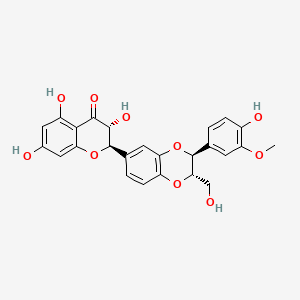
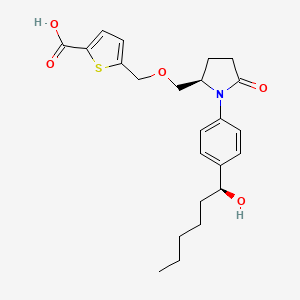
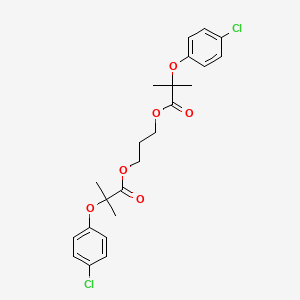
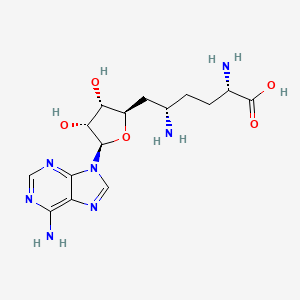
![10-allyl-1,13-dimethyl-10-azatricyclo[7.3.1.0~2,7~]trideca-2,4,6-trien-4-ol](/img/structure/B1681684.png)

![[2-[bis[(2S)-2-aminopropanoyl]amino]-3-methylphenyl] (2S)-2-[[(2S)-2-(3-hydroxyhexanoylamino)-3-methylbutanoyl]amino]-3-methylbutanoate](/img/structure/B1681687.png)
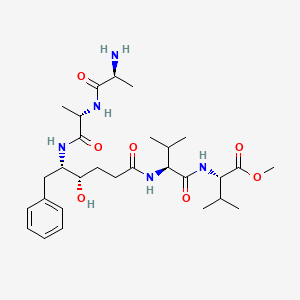
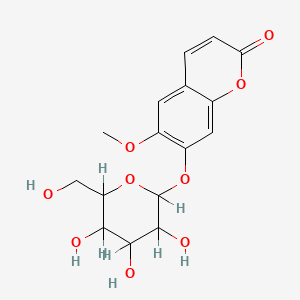


![N-hydroxy-1-(2-methoxyethyl)-4-[4-[4-(trifluoromethoxy)phenoxy]phenyl]sulfonylpiperidine-4-carboxamide;hydrochloride](/img/structure/B1681697.png)
